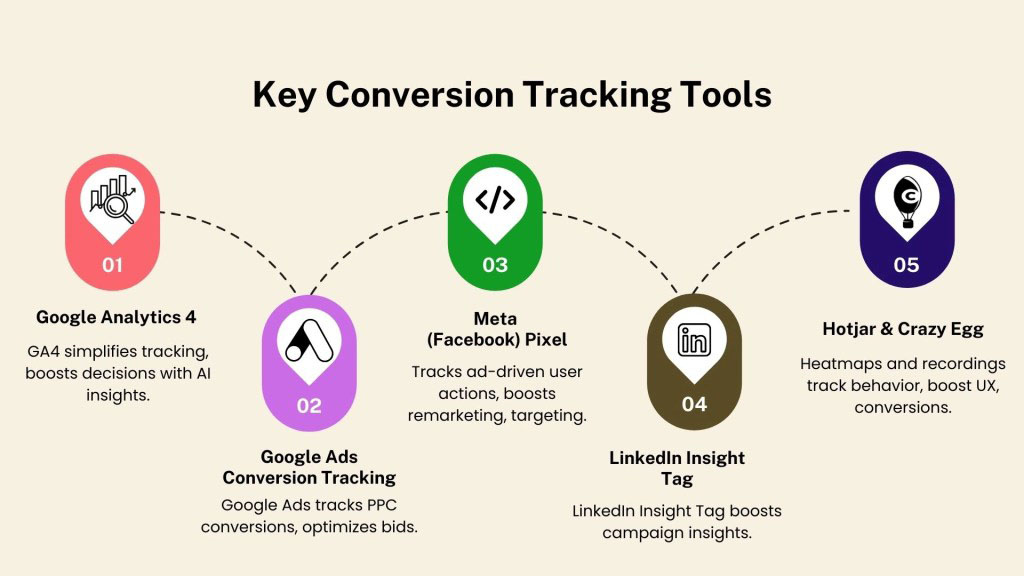In today’s digital marketing world, knowing what drives users to act is essential. Conversion tracking helps businesses monitor key actions like purchases, sign-ups, or form submissions. It reveals which campaigns, ads, or web pages deliver real results. With accurate tracking, brands can refine their strategies, improve performance, and boost ROI. This guide explores how conversion tracking works and why it’s a crucial part of successful marketing.
What is Conversion Tracking?
Conversion tracking is the process of keeping an eye on and studying what website or app users do that leads to a desired result. Sometimes people buy something, fill out a lead form, download something, click on a key link, or even call. These acts are called conversions. By tracking these conversions, marketers gain valuable insights into campaign performance and user behavior.
Why is Conversion Tracking Important?
Tracking conversions is an important part of making marketing work better. Businesses can make better budget decisions by finding out which outlets give them the best return on investment (ROI) . Businesses run without knowing what’s going on, losing money on ads that don’t bring in customers.
Moreover, conversion tracking allows marketers to refine campaigns by analyzing which ad creatives resonate best, which landing pages are most effective, and which audience segments convert the most. It also provides a deeper understanding of user behavior, enabling brands to create better experiences that drive engagement and loyalty.
How Conversion Tracking Works

Setting Up Conversion Goals
Before tracking conversions, it is essential to define what success looks like for your business. Google Analytics and other tracking platforms allow businesses to set up goals such as destination goals (e.g., ‘Thank You’ page views), duration goals (e.g., time spent on a website), event goals (e.g., button clicks, video views), and e-commerce goals (e.g., completed purchases).
Implementing Tracking Codes
Most conversion tracking tools require placing a tracking pixel or script on a website. Some of the key tracking methods include Google Tag Manager (GTM) , which provides a simplified way to add tracking codes; Facebook Pixel for tracking actions users take after clicking Facebook ads; and UTM parameters, which help track traffic sources through custom URL tags.
Analyzing Conversion Data
Once tracking is in place, marketers analyze key performance metrics such as conversion rate, cost per acquisition (CPA), and attribution models. These insights help businesses determine which marketing touchpoints contribute to conversions and where improvements are needed.
Understanding and Analyzing
This step includes looking at tracking data to find insights that can be implemented. You need to know how people act, which ads or websites work best, and where the sales funnel might be slowing down. This method can be improved by showing how people use your website through heatmaps, session logs, and cohort analysis.
Key Conversion Tracking Tools

Google Analytics 4 (GA4)
It’s easy to keep track of how people use websites with GA4. When businesses use advanced attribution modeling, track people in real time, and get better insights from AI, they can make decisions based on data.
Google Ads Conversion Tracking
Google Ads provides conversion tracking specifically for pay-per-click (PPC) campaigns. It enables businesses to adjust their bids based on performance data, optimizing ad spending for maximum returns.
Meta (Facebook) Pixel
This tool helps monitor user actions from Facebook and Instagram ads, allowing businesses to leverage remarketing strategies and refine their audience targeting.
LinkedIn Insight Tag
For businesses running LinkedIn campaigns , the LinkedIn Insight Tag provides valuable insights into ad performance, lead generation, and engagement tracking.
Hotjar & Crazy Egg
These tools track user behavior through heatmaps and session recordings, allowing businesses to improve user experience (UX) and optimize conversion rates.
Best Practices for Effective Conversion Tracking
Use Multiple Tracking Methods
Relying on a single tracking method can lead to data gaps. Combining pixels, event tracking, and UTM parameters ensures more accurate results and a clearer picture of user behavior.
Ensure Data Accuracy
Implementing tracking codes correctly using Google Tag Manager is crucial. Regularly testing conversion tracking by completing test transactions and monitoring discrepancies between Google Analytics and ad platforms helps maintain data integrity.
Leverage A/B Testing
A/B testing allows marketers to compare different landing pages, ad creatives, and call-to-action (CTA) elements to determine which variations drive the highest conversions. This process enhances the effectiveness of marketing campaigns.
Track Micro and Macro Conversions
Businesses should track both micro and macro conversions to gain a complete understanding of the customer journey. Micro conversions include actions like email sign-ups and social media follows, while macro conversions focus on revenue-generating actions like purchases and lead form submissions.
Implement Proper Attribution Models
Marketing attribution models determine how credit is assigned to different touchpoints in a user’s journey. First-click attribution gives all the credit to the first interaction, while last-click attribution gives all the credit to the last interaction before the sale. Linear attribution gives credit to all interactions in the same way. If you use the right model, you can see how your marketing efforts affect sales more clearly.
Common Mistakes to Avoid in Conversion Tracking

Not Setting Clear Goals
Without predefined goals, tracking data lacks direction. Clearly defining conversion objectives ensures businesses can measure success effectively.
Ignoring Cross-Device Conversions
Users often switch devices before converting. Implementing cross-device tracking ensures accurate attribution and a comprehensive view of user behavior.
Failing to Use Negative Conversions
Excluding unwanted actions, such as accidental form submissions, improves data accuracy. Marketers should refine tracking to focus only on meaningful user actions.
Conversion tracking is essential for optimizing digital marketing campaigns and improving ROI. By leveraging the right tools, setting accurate goals, and analyzing conversion data, businesses can refine their strategies, increase engagement, and drive higher profits. With precise tracking and data-driven decision-making, businesses can stay ahead in an increasingly competitive landscape.


